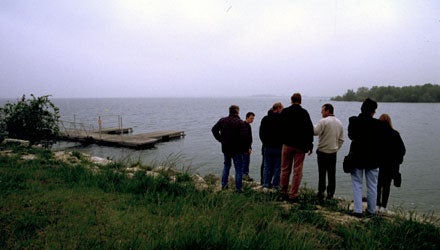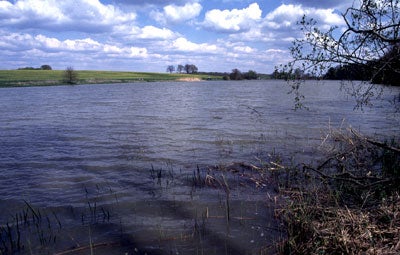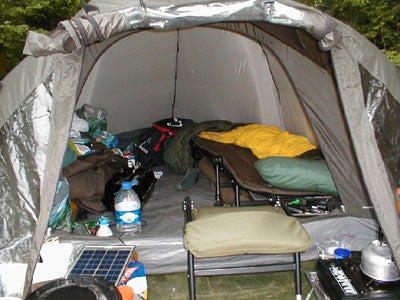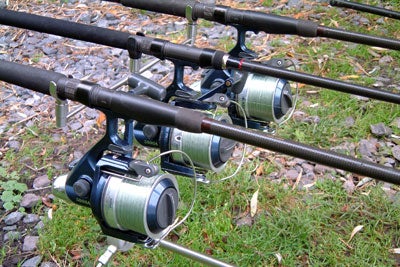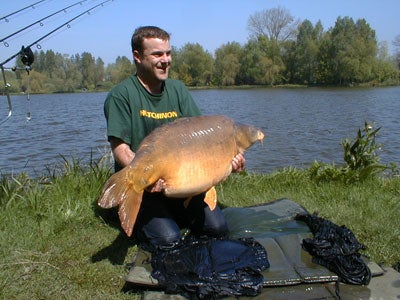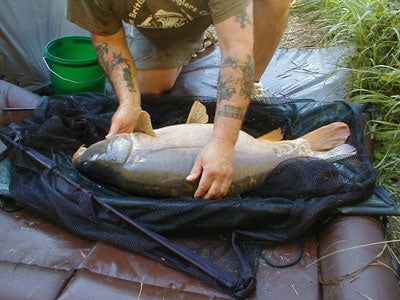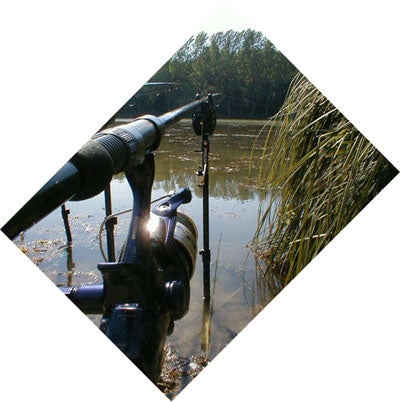A COMPREHENSIVE GUIDE TO CARP FISHING IN FRANCE In parts one and two we dealt with choice of water; how to go about booking it, getting there and the legalities involved, now we move on to what we may (or may not) need in the way of tackle. You will have chosen your venue carefully and this will to a large extent influence your choice of tackle. Groundwork is essential What is the size of the water you are going to fish? How big do the fish go? These are two very simple questions, but ones which will to a degree determine the type of tackle required. Never take lightly your approach as this could mean the difference between success and failure!
Smaller lakes will not present you with too many problems because you will probably have the required equipment and so your normal approach to carping in the UK will cope with the situation you are faced with in France. Your own technique can be applied for a successful week, and whatever tactics you have at your disposal can be employed in just the same way. However, some smaller lakes in France can still house some monsters so your tackle really needs to be ‘beefed up’ accordingly! Personally, I would not recommend tackling a water such as Lac du Der-Chanteqoc which is an artificially dammed reservoir of some 11,860 acres (this is massive by anyone’s standards), until you have a good deal of experience with the less demanding lakes first! Similarly, Lac de La Liez in Eastern France, a much, much smaller water, but still over 500 acres! To put it bluntly, until you have more experience you’d be ruddy daft to tackle lakes of this magnitude! Okay, so what tackle? Bearing all the above in mind let us go through all the essential items you will need to consider taking with you to cope with whatever may be presented before you. I won’t list items that are simply commonsense necessities such as a bedchair and sleeping bag, because no one would forget those, would they? Make up a check-list of everything you need; that you have already; and what you need to get. This way you’ll stay on top of the situation, and don’t leave anything until the last minute – this is the easiest way to forget something!
Bivvy: You may be used to using a small dome-type shelter or even a brolly with sides, but make sure you have a decent sized bivvy, preferably with a winter skin, as the weather can be as unpredictable in France as it is in the UK. Furthermore, you will undoubtedly need more tackle with you for the duration of your stay, and will need to house it all. Personally, I prefer to use a two man bivvy with an extended winter skin for this gives me the extra room and comfort I’m after.
Rods: For the majority of fishing in France your standard set-up will be adequate; many feel that a rod of 2.75lb test curve is standard, and this is fine. I landed a Sturgeon of 68lbs on my Browning 2.75’s without any problems; mind you I was a little worried at times! However, some waters contain very big carp – yes, even bigger than 68lbs, so don’t be afraid to up these to 3lb or even 3.5lb test curve, at least you can feel assured that you have the armoury to cope. Some waters allow the use of four rods, so if you feel comfortable using them, why not? Swim spacing tends to be such that you will have far more water available in front of you than in the UK. However, if it’s more of a ‘runs’ water you are going to, then you probably wouldn’t be able to cope with four rods, but then at such a place you would probably be limited to two or three anyhow! Reels: The balance needs to be right, which I’m sure you know already, but don’t make the obvious mistake of pairing a beefed up rod with a small reel, or vice versa! I’ve seen it done! For 2.75lb rods use something along the lines of the Shimano 10000 XTE, or a Shimano Big Baitrunner ‘M’, the latter being what I use. If you going for the 3lb or 3.5lb rods then go to a ‘Big Pit’ type reel. Again Shimano do some excellent reels for the job that will provide the all-important balance: the Technium 10000TX or less pricey, the Biomaster, or maybe a Long-Cast if you prefer the baitrunner (again what I use). Daiwa also produce superb reels and are many peoples’ preferred choice, such as the Tournament Basia 45 QD, the Infinity X, or again the less pricey Emcast.
Line: Check first of all with the rules for the water you are going to fish. Many, if not most, French waters do not allow the use of braid as a mainline, and some will insist on a breaking strain of not less than 15lbs – so choose it wisely! Rigs: Basically the same or similar rigs can be used in France, but in this connection, many French waters will not allow hooklengths of a greater breaking strain that the mainline. Many also do not allow leadcore or shockleaders, so bear this in mind also. It’s always best to check beforehand if you are not sure about anything. Hooks: Again, similar rules and principles can be applied to one’s choice of hooks, with bent hooks being banned on many French waters. Some will also have a minimum hook size requirement, for instance a size 4. Or their rules may state maybe a maximum size of 1.
Rod support: You may be wondering why I have included such a basic necessity on the list. Well, I have had experience of a Lake in Belgium (which shall remain nameless) where it was literally impossible to use bank-sticks; luckily I always take both bank sticks and a pod. This particular lake had varying sized lumps of concrete and lengths of iron in most swims! Not good! Also the last thing you want to be doing is having to resort to ‘hammering’ in banksticks! Unhooking Mat: Again a basic necessity, but at some venues a minimum size is stipulated. Also, always take Klinik or Medicarp and keep them by the unhooking mat, as well as a small bucket or large bottle filled with lake water to wet the mat and douse the fish, in fact you’ll find that most venues will insist on all these too. Baitboats: Love them or hate them, they can provide you with an advantage on many waters. By no means a necessity, but very useful all the same, and I would never be without mine whilst fishing in France! For precise bait placement there is nothing better! Have an echo sounder fitted to one and you instantly have an excellent means of mapping out the topography of the lake bed – essential for locating potential feeding areas and patrol routes of the carp, and an easy way to spot potential snags! Yes, I know all this can be done quite easily using the more traditional method of marker float and lead set up, but its also good sometimes to use the technology to hand – and let’s face it, why are you going to France in the first place? One reason has to be to catch more and bigger carp, so why not use every means at one’s disposal. An echo sounder will also show where fish are located in the swim!
Clothing: Obviously not items of tackle, but ensure you have an adequate supply of spare clothing; you won’t want to wear the same clothes all week will you? Consider the possibility that you have a run whilst it is raining! Are you going to run around naked whilst your clothes dry off, frightening the local maidens? No, of course not! Most venues have basic facilities such as toilets (de toilette) and showers (le douche), so remember also to take towel(s), shower gel, etc. Also there are often English style electrical sockets for charging batteries, shaving, etc. Best to check first though! What Methods or Tactics are you going to employ? Very simply, the same methods you would make use of in the UK – with carp care being of the utmost importance! Some French lakes are full of snags, and I mean BIG snags; whole trees are sometimes found in bays and so on. Great care must therefore be undertaken to ensure no carp becomes tethered; making sure all leads can easily come free.
Dependant on the time of year (as with the UK) single hookbaits can work, as can very large piles of bait. Obviously it’s always best to start with small amounts and build up if considered necessary – but more of that in Part Four. In using three or four rods you will be able to experiment perhaps a little more than usual, so it is worth considering the method feeder, single fluoro pop-ups, larger boilies than normal – great if you make your own, you can roll some real ‘donkey-chokers’! Maize or corn can work well as can artificial corn, or a mixture of the two. Bear in mind also that some lakes in France have species that can be a nuisance, such as Poisson Chat (small catfish) and Crayfish. If these move onto your bait you may be in for some troublesome nights. However, where you find crayfish, carp are not far away! For dealing with these two little devils though, for they can be a real nuisance, try air-drying your baits, or try caging or meshing them, this should do the trick.
Planning, preparation, groundwork, knowledge, comfort, well-being, determination, relaxation, confidence, peace-of-mind, contentment, reassured, elation, jubilation, success! Keep in mind these words and any others you can think of as relevant reminders of what you want from your trip, and you should do well. Remember, one of the principal considerations is that you are going to be happy for the week with what you are attempting to achieve, and comfortable in accomplishing your goals. You are investing a lot of time, effort and money into your adventure, so cut no corners. Take as much tackle as you physically can because you may have difficulty finding a tackle shop in France if you should run short. They are there of course and you will find them much cheaper than UK shops. You will also find fishing tackle sections in many of the local supermarkets but these tend to be aimed at the match angler, so will not be of much use and certainly will not stock items such as hooklength materials or PVA for example. Finally, don’t forget to take your cameras, spare film if you don’t have digital, and spare batteries for your bite alarms. Part 4 – ‘Bait’ |
Welcome!Log into your account










